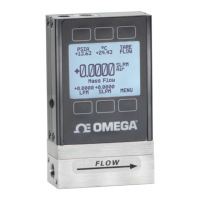
Do you have a question about the Omega FMA-1600A Series and is the answer not in the manual?
| Brand | Omega |
|---|---|
| Model | FMA-1600A Series |
| Category | Measuring Instruments |
| Language | English |
Steps to configure measurement units and connect the flow meter.
Monitoring live readings and capturing totalized data.
Identifying key components and their functions on the device.
Basic maintenance recommendations and calibration advice.
Explains the flow meter display and status messages.
Guidance on installing the flow meter in various positions.
Information on using in-line sintered filters for particulate prevention.
Instructions for connecting the flow meter and pressure limits.
Details on power supply and signal connections using the Mini-DIN connector.
Explanation of the linear output signal provided by the device.
Information on the secondary analog output signal available on the Mini-DIN connector.
How to remotely tare the device using a ground connection.
Requirements for using a 4-20 mA current output signal.
Describes the primary functions of the main display screen.
Explains the process and importance of taring the flow meter for accurate measurements.
Explains color coding for parameters on TFT displays.
Details on how the totalizer handles reaching its maximum count.
Information about device model, serial number, and calibration dates.
Displays the maximum calibrated ranges for flow and pressure readings.
Contact details and web address for the manufacturer.
Reconfigure flow meter for different gases using Gas Select™.
Define new mixed gas compositions for accurate flow readings.
Steps and commands for defining new mixed gas compositions.
Methods for managing existing COMPOSER™ gas mixes.
How to change measurement units for display and data.
Setting standard temperature and pressure references for calculations.
Adjusting time constants for smoothing fluctuating readings.
Setting a threshold below which flow values are displayed as zero.
Setting a unique identifier for devices connected to a network.
Identifier for devices on a Modbus network.
Configuring the data transfer speed for serial communication.
Configuring button actions and display of barometer values.
Adjusting contrast and brightness for displays.
Option to invert (flip) the screen display.
Restoring device settings to factory defaults for troubleshooting.
Viewing live values of internal device registers for diagnostics.
Cautionary advice on editing device settings.
Details on establishing Modbus communication.
Steps for serial communication setup via COM ports.
Using software like PuTTy for serial communication.
Step-by-step guide to configure PuTTY for serial communication.
Faster method for defining COMPOSER™ mixes using serial commands.
Common issues with device power, buttons, display, and analog signals.
Troubleshooting negative readings, settling, and comparisons with other meters.
Guidelines for cleaning the exterior of the flow meter.
Information on annual recalibration procedures and contact.
Lists various pressure, flow, temperature, and time units.
Detailed list of pressure units and their conversions.
Detailed list of volumetric and mass flow units.
Units specific to true mass flow measurements.
Units for total volume or mass measurements.
Standard temperature units.
Units for time measurements.
Pinout diagram and functions for the 8-pin Mini-DIN connector.
Pinout diagram and functions for the locking industrial connector.
Pinout diagrams for common 9-pin D-Sub connectors.
Pinout diagrams for common 15-pin D-Sub connectors.
Pinout diagrams for common M12 connectors.
Procedures for submitting warranty and repair requests.